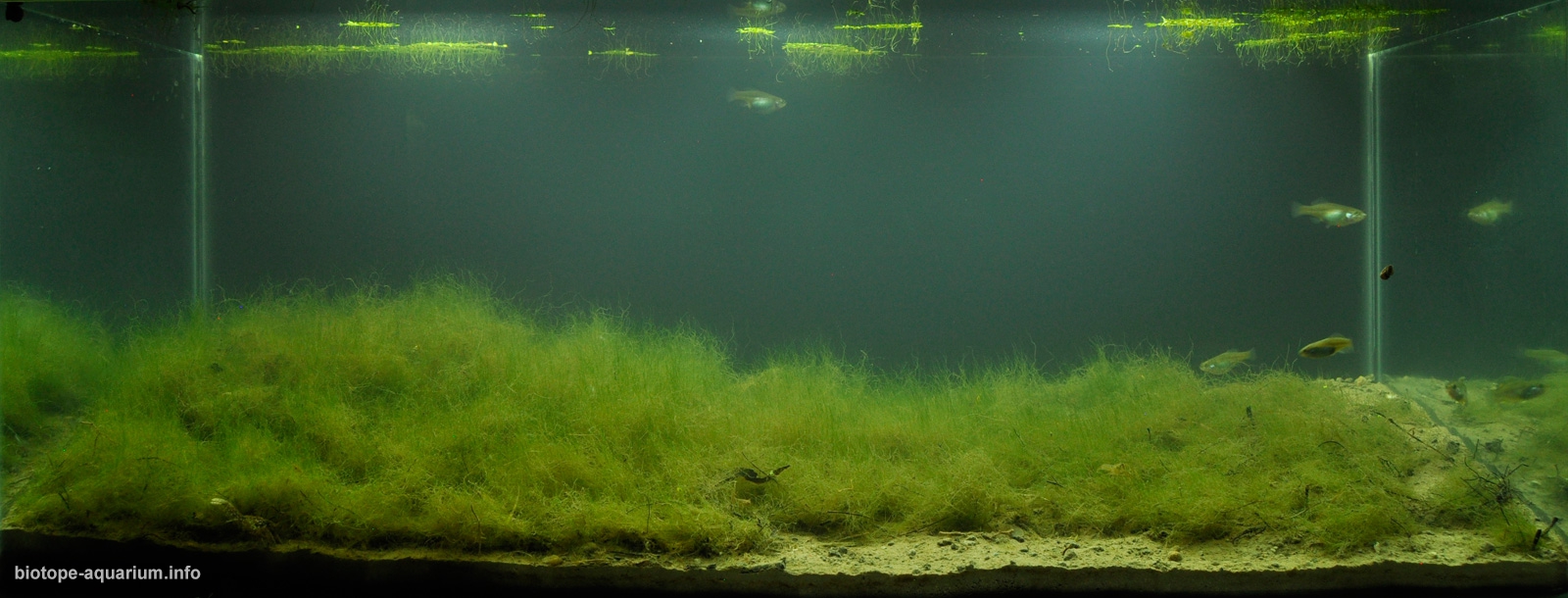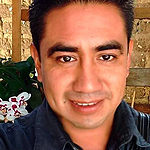A stream on private property, habitat for Girardinichthys multiradiatus. El Pedregal, Ocoyoacac, Mexico
64th place in Biotope Aquarium Design Contest 2018
![]() Mexico. Amadeo Hernández Pérez
Mexico. Amadeo Hernández Pérez

Volume: 112 L
Dimensions: 85x40x33 cm
List of fishes: Girardinichthys multiradiatus, Cambarellus montezumae, Gammarus sp., Physa sp., Planorbidae
List of plants: Spirogyra sp., Lemna sp.
Description of decorations: The filamentous algae used in the aquarium were collected from the natural environment; the substrate that is used is mountainous land to simulate the soft and muddy substrate of the recreated biotope.
Description of equipment: Internal filter AquaJet 300 (300 lph) and 3 fluorescent bulbs (32W, 6500K). There is a photoperiod of 8 hours a day with daylight influence for 1 hour.
Water parameters: Ammoniacal nitrogen (N-NH3): 0.03 mg/L, Nitrites (NO2-): 0.03 mg/L, Nitrates (NO3-): 0.06 mg/L, Phosphates (PO4-3): 0.31 mg/L, pH: 7.12 , Temperature: 19±1°C, Turbidity (NTU): 2 and SST: 2 mg/L.
INFORMATION ABOUT BIOTOPE
Description of the area surrounding the biotope: The stream is privately owned and opens up along the garden of the house where the predominant vegetation is grass (Pennisetum clandestinum), and there are also very few ornamental plants (Agapanthus africanus, Rosa sp., Prunus sp. and Ligustrum sp.) And trees locally known as “Weeping Willow” (Salix sp.) which influence more on the aquatic landscape.
Description of the underwater landscape of the biotope: The stream is not greater than 35 m long and 1m wide with an average depth of 15 ± 5 cm; the substrate (soft and muddy) is mostly covered by filamentous algae (Spirogyra sp.). Before the minor movement in the water column, the organic matter and the sediments present in the bottom are altered, which are dragged by the moderate current present in the stream. Thanks to the shallow depth and crystal clear water you can see the beauty of the fish commonly known as “Mexcalpique” (Girardinichthys multiradiatus) who are showing courtship behavior at all times and who find refuge in algae colonies in the presence of humans. You can also observe the food activity of the locally known “acociles” (Cambarellus montezumae). What has most influence on the aquatic environment in certain areas are the “willows” (Salix sp.) who demand a high concentration of moisture, so that their root system (very developed), some branches and leaves can be seen in the water column.
Description of the parameters of the habitat: Physical and chemical parameters taken at the beginning of summer: Ammonia nitrogen (N-NH3): 0.04 mg/L, Nitrites (NO2-): 0.08 mg/L, Nitrates (NO3-): 1.0 mg/L, Phosphates (PO4-3): 0.28 mg/L, pH: 7.19 , Temperature: 18±2°C, Turbidity (NTU): 2 and SST: 1 mg/L.
List of fishes and invertebrates occurring in the nature biotope: Girardinichthys multiradiatus, Cambarellus montezumae, Gammarus sp., Planaria sp., aquatic snails of the genus Physa and the family Planorbidae, frogs of the genus Hyla and even some snakes of the genus Thamnophis.
List of plants found in the nature biotope: As aquatic flora Spirogyra sp. and Lemna sp., in the terrestrial part Pennisetum clandestinum, Agapanthus africanus, Rosa sp., Prunus sp., Ligustrum sp. and Salix sp.
Threats to the ecology: The stream does not face any threat, however, it naturally hosts a small population of Mexcalpiques (Girardinichthys multiradiatus), fish belonging to the Goodeidae family that is endemic to the central part of Mexico, an area considered by the Word Conservation Monitoring Center as a of the most important regions of the world for the conservation of freshwater fish since here is the main zone of freshwater wetlands of the country with a unique diversity of fish (Domínguez-Domínguez and Pérez-Ponce de León, 2007), in the that the godeids are one of the most representative groups (Domínguez-Domínguez et al., 2006) and are the dominant element of the distinctive ichthyofauna of the Lerma river, Mexico (Rush-Miller, 2009). The godeids are a natural treasure since they have unique adaptations among which are: A) Internal fertilization in which the males have a modification in the anal fin in the form of a copulatory lobe (spermatopodium) that plays a crucial role in the transfer to the interior of the female of the spermatic pack and B) Form of embryonic nutrition (matotrophy) in which the embryos have a specialized structure to obtain nutrients and macromolecules (lipids and proteins) and for gaseous exchange with the female. This structure (trophotenia) is formed in the ventral part at the level of the anus once the embryo is expelled to the lumen of the ovary, where it completes its development (Domínguez-Domínguez and Pérez-Ponce de León, 2007). Like most of the aquatic fauna that lives in bodies of water in central Mexico, this family is in serious risk of disappearing because the hydrological system of the Lerma River has one of the largest volumes of water extraction in the country, both groundwater as surface water; At the same time, its basin supports one of the most significant economies in the country with a large number of industries and agricultural areas on its banks, making it one of the most polluted and impacted basins in the world. Ironically this river is one of the most important for the ichthyological diversity of the country because it hosts the largest number of Goodeid species (16 species) and has one of the highest rates of fish endemism, which globally reaches 66% (Domínguez-Domínguez and Pérez-Ponce de León, 2007). It is important to mention that in the red list of endangered species by the International Union for the Conservation of Nature (IUCN) considers Girardinichthys multiradiatus as a vulnerable species, while Cambarellus montezumae lists it as of minor concern; On the other hand, these species are not included in NOM-059-SEMARNAT-2010. However, as already mentioned in previous lines, the upper basin of the Lerma river is one of the most impacted in the world, an impact in which anthropogenic activities such as 1) the unsustainable use of natural resources, 2) the fragmentation of bodies of water due to the change in land use for the expansion of agriculture, urban and industrial growth and the construction of road infrastructure, 3) desiccation due to exploitation of groundwater and alteration of hydrological dynamics, 4) Water pollution due to the discharge of domestic and industrial wastewater leaves an indelible mark on the distribution areas of these representative species of the country. Acknowledgments: Ing. Juan Hernández Flores (neighbor of the area) and Luciano Piedra Quiñones (owner of the land) for guiding me and allowing me access to the area to determine the parameters, characteristics, flora and fauna present in the biotope. Here is my grain of sand for the conservation of endemic aquatic species of Mexico through biotope aquariums.
Sources of information:
*Domínguez-Domínguez, O., Pérez Ponce de León (2007). Goodeids, endemic fish from central Mexico. CONABIO Biodiversists 75: 12-15.
*Navarrete-Salgado, Norma A .; Rojas-Bustamante, Margarita L.; Contreras-Rivero, Gilberto; Elías Fernández, Guillermo. (2007). Feeding of Girardinichthys multiradiatus (Pisces: Goodeidae) in the La Goleta reservoir, State of Mexico. Ergo Sum Science, vol. 14, No. 1. March-June, 2007, pp. 63-68. Autonomous University of the State of Mexico, Mexico.
*Navarrete-Salgado, N.A., Cedillo-Díaz, B.E., Contreras-Rivero, G. and Elías Fernández, G. (2007). Growth, reproduction and survival of Girardinichthys multiradiatus (Pisces, Goodeidae) in the San Miguel Arco reservoir, State of Mexico, Chapingo Magazine Forestry and Environmental Sciences Series 13 (a): 15-21, 2007.
*Naranjo-García, E. (2003). Mollusks continental of Mexico: Freshwater. Rev. Biol. Trop. 51 (Suppl.3): 495-505, 2003.
*Rush-Miller, R., Minckley, W.L., Mark-Norris, S. (2009). Freshwater fish from Mexico. 1st Ed. National Commission for the Knowledge and Use of Biodiversity. Chap. SAW.
*Online consultation:
–http://www.iucnredlist.org/
–http://www.iucnredlist.org/
–http://biotope-aquarium.info/
Comments of the members of the jury of Biotope Aquarium Design Contest 2018

An aquarium that at first sight seems very simple, but that, according to supporting material, is a very good recreation of a part of the stream, and the used species are a special merit. As a recommendation I would make the corners of the aquarium not visible in the main photograph. Congratulations!
